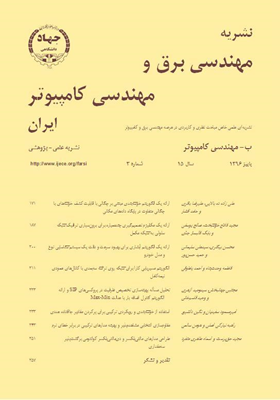مقاومسازی انتخابی مشاهدهپذیر و بهینه مدارهای ترکیبی در برابر خطای نرم
محورهای موضوعی : مهندسی برق و کامپیوترراهبه نیارکی اصلی 1 , هومن سالمی 2
1 - دانشگاه گیلان
2 - دانشگاه گیلان
کلید واژه: خطای نرم مدار ترکیبی مشاهدهپذیری قابلیت اطمینان بار بحرانی,
چکیده مقاله :
کاهش مقیاس تکنولوژی و کاهش سطوح ولتاژ باعث حساستر شدن گرههای مدارات مجتمع و رشد فزاینده خطای نرم در آنها شده است. خطای نرم سبب اختلال گذرا در کار مدار میگردد و اهمیت آن در مدارهای ترکیبی با افزایش فرکانس کاری بیشتر میشود. در این مقاله روشی بهینه برای مقاومسازی مدارات ترکیبی در برابر خطای نرم ارائه شده است. بهینهسازی روش پیشنهادی در سه مرحله انجام میگیرد. ابتدا با محاسبات مشاهدهپذيري، اولویت گرههای مدار از نظر مقاومسازی تعیین میگردد. سپس به منظور بهینهنمودن پارامتر توان- تأخیر و سطح مصرفی مدار، قابلیت اطمینان مدار اندازهگیری میشود و با توجه به آن، تعداد گرههای لازم برای مقاومسازی تعیین میگردد. در مرحله بعد، گرههای انتخابی از مدارهای استاندارد آزمون با سه روش مختلف که شامل افزونگی زمانی، اشمیت تریگر و پسخورد ترانزیستوری میباشند مقاومسازی میشوند. مقایسه سه روش نشان میدهد که مدار مقاومشده با اشمیت تریگر، دارای بیشترین بار بحرانی و کمترین فاکتور توان- تأخیر است. همچنین نتایج شبیهسازی تأیید میکند که مقاومسازی بهینه حاصل انتخاب مناسب تعداد گرههای لازم با استفاده از مفهوم مشاهدهپذیری و محاسبات قابلیت اطمینان همراه با نوع مناسب مقاومسازی گره میباشد. اجرای روش پیشنهادی بر روی مدارهای تحت آزمون از 85ISCAS مؤثربودن روش را تأیید میکند. همچنین شبیهسازی مونت کارلو نشان میدهد که روش پیشنهادی در برابر تغییرات فرایند مقاوم است.
Due to the shrinking of feature size, reduction in supply voltage and technology scaling, the sensitivity to radiation induced transient faults of digital systems has dramatically increased. Soft error causes transient distortion in circuit operation and is expected to become very important in combinational logic with increment of the circuit frequency. In this paper, we introduce an optimized method for hardening of combinational logic circuits against soft errors. In this method, first we have found the most sensitive nodes of the circuit by observability computations. Next for optimizing power-delay product and area, the reliability of the circuit has been computed and the number of the necessary nodes for hardening will be identified. In the next step, three different hardening methods including time redundancy, Schmitt trigger and transistor feedback have been carried out on standard test circuits as our vehicles. The comparison of three method results show that the hardened circuits with Schmitt trigger have the most cumulative critical charge and the least power-delay product and lead to an optimum hardening. Moreover, the simulation results approve the optimized hardening is obtained from suitable selecting the number of required nodes considering observability concepts and reliability computations together with the best node hardening method. Monte-Carlo simulations also approve the performance of the proposed method against process variations.
